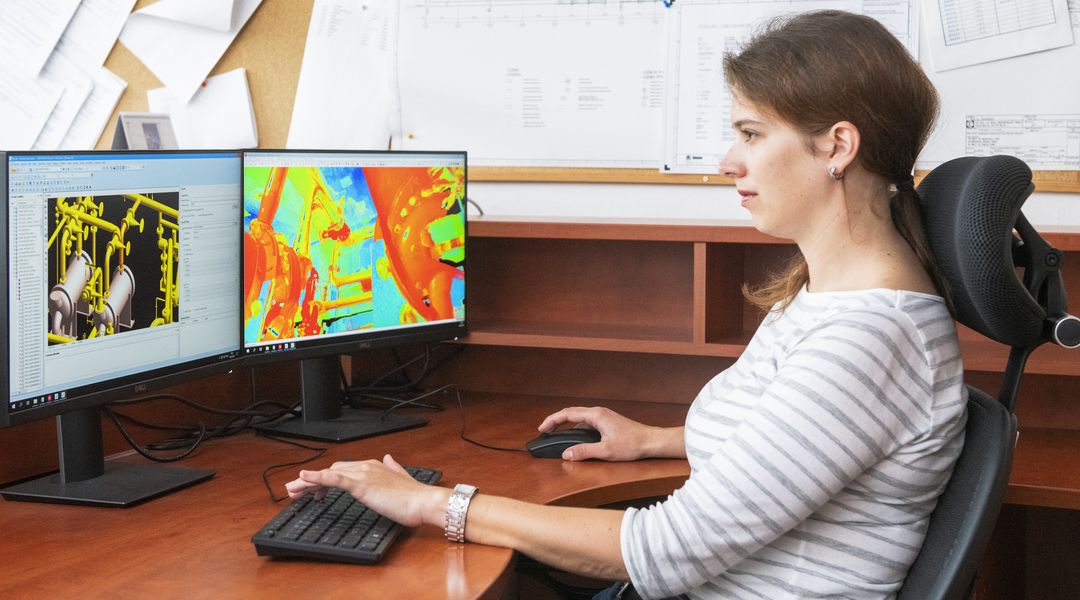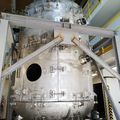Design

Spatial Coordination at the Mochovce, Dukovany and Temelín NPPs

At the beginning of 2018, we started the creation of a 3D model of the actual condition for the post-installation cleaning operations stage at Mochovce NPP Unit 4 and successfully completed the work at the end of 2018 according to schedule. The result is documentation for approximately 2,800 pipeline routes and auxiliary steel structures. Approximately 140 scans of the main production unit technology served as the basis for this work. In parallel, we have developed a 3D model of the steam-water piping system (from the steam generator to the hermetic penetration) at Dukovany NPP Units 1, 2 and 4. This model was prepared from scans taken in the main production unit buildings. The documentation from this model was used as a basis for the piping calculations.
Since 2019, activities related to the finalization of the Unit 4 completion project at Mochovka NPP are continuing successfully. In the period 2019-2021, documentation of the actual design for approximately 1,600 pipeline routes and auxiliary steel structures was prepared.
Spatial coordination using PDMS tools and laser scanning is increasingly being used to check the actual condition after installation, prior to submitting individual plant designs for construction testing and to verify and produce final as-built documentation. Among other things, it is also used to verify the original documentation of old equipment delivered during the original construction of Mochovce 3,4 NPP (verification of the actual dimensions of the equipment against the original documentation). Data from approximately 400 additional scans with many individual sites were used as a basis for all these activities.
As the fuel has been successfully loaded into the reactor vessel at Mochovce NPP Unit 3, it can be expected that the work on the completion of Unit 4 will become more intense towards the end of 2022 and during 2023.
Since March 2022, the project “F972 – TQ, TX – transport of inaccessible 6kV motors” has been implemented for ČEZ, a.s. and its nuclear power plant Temelín, which was successfully submitted to the customer (ČEZ, a. s.) for comments in November 2022. This was a complex and challenging project, which aimed to identify the transport routes where the currently inaccessible large motors (24 motors weighing 3-5 tonnes in total) of the TX and TQ systems (emergency power systems) could be transported out of the main production unit if necessary and to find any collisions on the transport routes. The final output was technical reports describing the transport of each motor separately.
The preparation of the final technical reports took was time-consuming and it involved different parts of the company (for the D1 – Engineering and I&C – the Design and Technical Preparation of Assemblies, and for the D3 – Nuclear Division – the Mechanical Design department).
The first step after the transport routes were laid out was to scan all the affected areas (30 scans were carried out, with a total of 581 scanner stations). This was followed by the refinement of the PDMS model of Temelín NPP supplied by the client within the scope of the defined transport routes. In the meantime, fixtures for individual manipulations were designed by the assembly preparation engineer. These data were finally collected in the Virtual Reality department, where the animation of individual transports was processed and the collision technology was defined. Based on these findings, the final technical reports could then be produced.
Modernization of the Polar Bridge Crane in Units 1 and 2 at the South Ukraine NPP

The project will include complete replacement of the control management system and electrical components of the polar bridge crane. In the mechanical part of the crane, the existing 80-ton crane trolley will be replaced with a new trolley with a capacity of 160 and 2×80 tons. The crane trolley of the main 400-ton hoist will be equipped with a new hoist mechanism, trolley travel mechanism, equipped with an emergency brake, a new cable drum and wire rope, and the auxiliary 10-ton hoist with a block with a swivel fork will be replaced. Also replaced will be the rotation mechanism of the polar crane bridge, the runway rail for the cable folding system, and special loading and handling tools will be designed and supplied for disassembly and assembly.
Emergency Containment Depressurization (Venting) at Ukrainian Nuclear Power Plants

This project, including the design, deliveries, assembly and commissioning, is being implemented by ŠKODA JS in cooperation with the FRAMATOME Company and other companies at eleven VVER 1000 nuclear units in Ukraine. The design phase of the project took place in 2018. The complete documentation was prepared in line with the GOST and PNAEG standards. Venting is a passive system, which in the event of an increase in pressure inside the containment will release, through a filtration system, a mixture of steam and gas into the surrounding environment. It is a two-stage filtration system contained in a vessel 3.4 meters in diameter and 5 meters in height. Due to the temperature specification of 295°C and seismic resistance requirements, the vessel was made of 08Ch18N10T material of a thickness ranging between 22 and 24 mm. The assembly of the tank, consisting of 34 parts, took place on site, as the clearance of the only transport route is a mere 60 x 160 cm.
The filtration process itself takes place in the vessel and the required filtration effectiveness is 99.999%. The system also serves to remove heat from the containment, which is achieved by steam condensation inside the vessel.
ŠKODA JS supervised the assembly of the systems and directly managed the installation and welding of the main pressure vessel of each system. The handover documents are currently being finalized. The completion of the entire project is scheduled for the second half of 2023 due to the situation in Ukraine.
Cask for Leaky Spent Fuel for the Temelín NPP
We are ready to offer our customers a packaging assembly (cask) for leaky spent fuel. Its main feature is that it allows to accommodate not only individual fuel rods (removed from fuel assemblies), but especially entire fuel assemblies, where one of the fuel rods has been found to be leaking, without the need to remove them.
The development of the cask was based on a modification of the existing design of our own ŠKODA 1000/19M cask for VVER-1000 type spent fuel. In the design and construction phase of the development, we paid the greatest attention to the safe procedure of cask clearance at the nuclear power plant, due to the risks associated with leaking fuel. To this end, in addition to calculations and analyses, we performed a number of verification experiments. The result of cooperation with expert bodies – ÚJV Řež, VŠCHT Prague (University of Chemical Technology), TĚSNOST Plzeň and others – is the ŠKODA 1000/19N packaging assembly. Our company is currently starting the process of type approval (licensing) for this cask.
Deep disposal – end of fuel cycle
In 2021, ŠKODA JS successfully completed the project “Research and Development of a Storage Cask for Deep Disposal of Spent Nuclear Fuel”. The aim was to completely design a storage cask for deep disposal of spent nuclear fuel from VVER 440 reactors and supply a sample of this cask to the Radioactive Waste Repository Authority (SÚRAO). This spent fuel cask sample for VVER-440 fuel is currently displayed in the Faculty of Mechanical Engineering of the University of West Bohemia.
Science and Research

Within subsidy programs, we intensively worked with the Generation IV reactor technology based on molten salt and helium. We also developed a Hydrogen Steam Autoclave for the Řež Research Center. The new system allows for testing of changes to material properties in an environment of overheated water steam with an addition of hydrogen, a hydrogen steam mixture. One of the effects examined is, for example, hydrogen embrittlement.
As part of ŠKODA JS a.s.’ internal development, we are also developing our own experimental program dedicated to verifying the thermohydraulic properties of fuel assemblies for both VVER-1000 and VVER-440 technology. In the past years, in cooperation with the D2 Division (NPP Service), we have dealt with experimental verification of hydraulic resistance coefficients of fuel assemblies and their components. These activities were carried out within the framework of development of licensing documentation and overall licensing management of introduction of new fuel types at Temelín and Dukovany. We are currently approaching the technological testing of the critical heat flux identification stand, which has historically been operated by Škoda and is currently being re-commissioned as part of a grant project.
Hněvkovice and Kořensko Hydroelectric Plant
Based on a request of ČEZ, a. s., the Laserscan project of the Hněvkovice hydroelectric power plant and the Kořensko hydroelectric power plant was implemented in 2019. These power plants are located in the dams of the Hněvkovice and Kořensko reservoirs on the Vltava River. The Hněvkovice power plant has two vertically mounted Kaplan turbine sets (2 × 4.8 MW).

Kořensko

Hněvkovice
In the power plant of the Kořensko reservoir, there are two horizontally positioned sets of direct-flow Kaplan turbines (2 × 1.9 MW).
Laserscan was implemented at the Hněvkovice power plant at a time when one of the units was undergoing an overhaul. The entire unit was dismantled, providing a unique opportunity to scan a structural part that is completely inaccessible during operation. The laserscan was carried out using the new Leica RTC360 scanner, which enables significantly faster scanning. During the scanning work, almost the entire technology and structure of the Hněvkovice hydroelectric power plant was captured. In total, 5 scans were carried out at this power plant (with a total of 173 scanner stations).
A total of 4 scans (with a total of 85 scanner stations) were carried out at the Kořensko power plant.
This data together with the paper documentation formed the basis for the creation of the illustrative, explodable 3D models of the Kaplan turbine set illustrated in the figures.
The history of our cooperation

2018 the creation of a 3D model of the actual state of the Post-assembly clean-up operation at Unit 4 of the Mochovce NPP

2018a 3D model of the piping of the steam/water system (from the steam generator to the hermetic penetration) in Units 1, 2 and 4 at the Dukovany NPP was created

2018the design phase of the “Emergency Containment Depressurization (Venting) at Ukrainian Nuclear Power Plants” project

2018design activities in connection with the development of a cask for leaky VVER 1000 spent fuel

2019Laserscan project of internals of the main production unit at Dukovany NPP
Interesting numbers
2800 pipelines and auxiliary steel structures at Unit 4 of the Mochovce NPP scanned